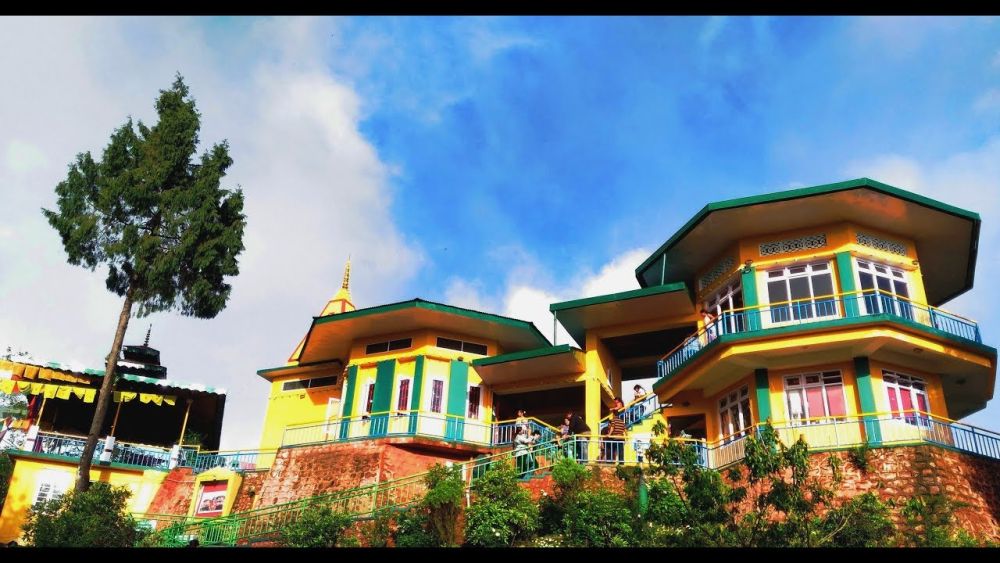

Ganesh Tok is a small yet significant Hindu temple dedicated to Lord Ganesha, perched on a hilltop in Gangtok, the capital of Sikkim. Located just 6 km from the main town and at an altitude of 6,500 feet, the temple offers panoramic views of Gangtok, along with the surrounding hills and the majestic Mount Kanchenjunga, the third highest peak in the world.
The history of Ganesh Tok is closely tied to the cultural and religious fabric of Sikkim. The temple itself is relatively small, with the idol of Ganesha housed in a modest-sized room that can only fit one person at a time. Visitors must climb a set of stairs to reach the shrine. Nevertheless, its significance comes from the belief in Ganesha as a remover of obstacles and the god of new beginnings, which leads many visitors to start their exploration of Sikkim with a prayer at this temple.
Although the exact date of establishment for Ganesh Tok is not documented, the rise in its popularity is attributed to the growth of tourism in Gangtok and the interest in Sikkim's natural beauty and cultural heritage. Since Sikkim's merger with India in 1975, the region has seen a steady increase in visitors, and places of worship like Ganesh Tok have become essential stops on the itineraries of both domestic and international tourists.
In recent years, eco-tourism and sustainable travel practices have been gaining momentum in Sikkim, with Ganesh Tok being part of this movement. The temple itself encourages cleanliness and environmental awareness, mirroring the state's broader initiatives to maintain its pristine surroundings. Sikkim was declared India's first fully organic state in 2016, further enhancing its appeal for visitors seeking environmentally responsible travel options.
Another trend in the area is the growth of spiritual tourism. Pilgrims and spiritually-minded travelers are increasingly visiting Ganesh Tok as part of a circuit that includes other religious sites in Sikkim like the Rumtek Monastery, Hanuman Tok, and the Namgyal Institute of Tibetology. The practice of combining spiritual journeys with the appreciation of natural beauty is a hallmark of Sikkim's tourism sector.
Furthermore, the development of infrastructure around Gangtok with better roads, more accessible transportation options, and improved accommodations is also a notable trend. These enhancements have made it easier for tourists to visit Ganesh Tok and enjoy its tranquility and views.
Lastly, the increased use of digital platforms and social media for tourism promotion has introduced Ganesh Tok to a broader audience. Vivid images and travelogues shared online often feature the temple and its picturesque backdrop, enticing visitors with the promise of peace and panoramic beauty.
For visitors planning to go to Ganesh Tok, the best time to visit is between March to late May or October to mid-December when the sky is clear, and views of the Himalayas are unobstructed. Outside of these months, the area can be prone to heavy rains or cold temperatures that may hinder travel plans.
Upon arrival, tourists can enjoy not only a moment of spirituality but also terrific photo opportunities, with the viewing lounge and circular balcony providing a 360-degree outlook. Traditional attire is available for rent at Ganesh Tok, allowing visitors to dress in local Sikkimese clothing for photographs. Nearby attractions include the Flower Exhibition Centre, Tashi Viewpoint, and the Himalayan Zoological Park, making Ganesh Tok a focal point for a rich cultural and natural excursion.
Ganesh Tok stands not just as a place of worship but also as a beacon for those traversing the diverse terrains and traditions of Sikkim. Its spiritual allure combined with the breathtaking landscape encapsulates the charm of Gangtok, making it a timeless and ever-evolving highlight for travelers exploring the Himalayan region.